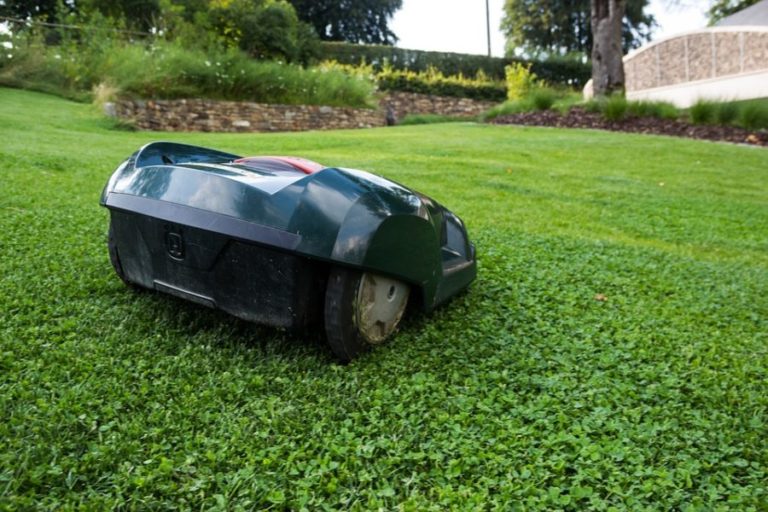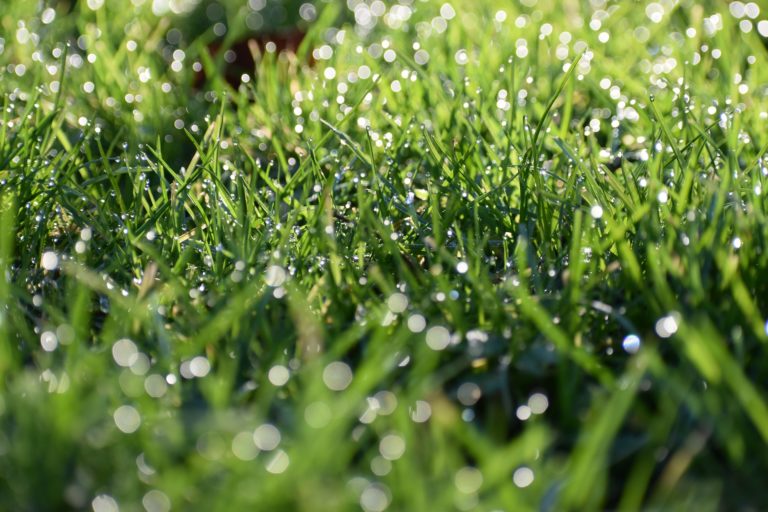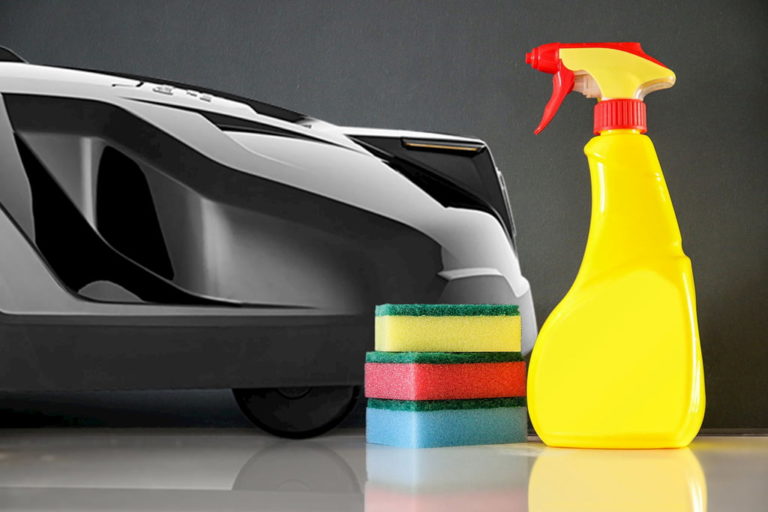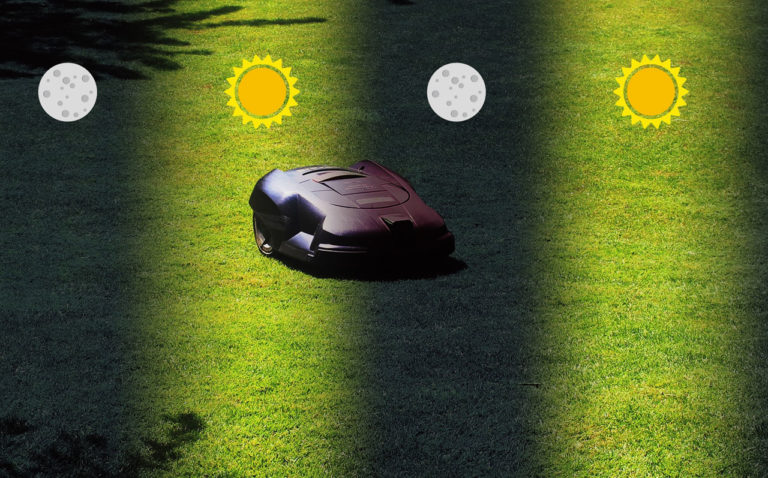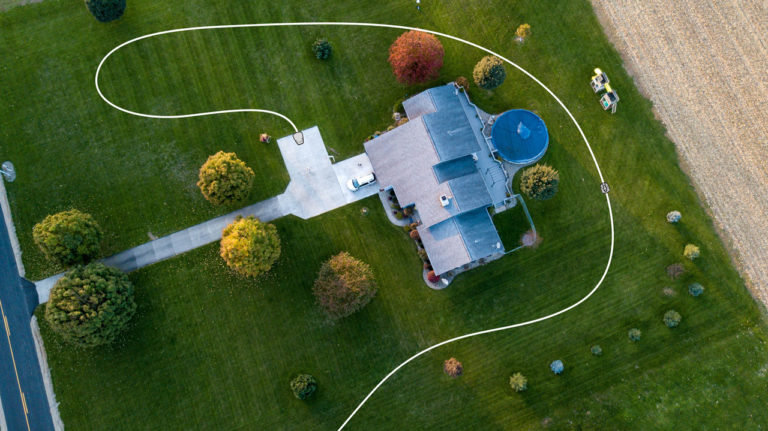There are robotic mowers that mow in a seemingly random manner and others that travel in orderly, linear paths. But which of the two systems is better? And are there differences as to which type of yards they are suitable for?
Is the random or the systematic mowing system better? The question whether the random or the systematic mowing system is better for a robotic mower to use is almost a question of faith. Most manufacturers now rely on the random system, as the advantages of this system tend to outweigh the disadvantages, so it could be called the better of the two systems.
It is really not easy to answer this question, because in some cases vehement battles are already being fought over this in discussion forums. Everybody is convinced of their technique and brings their own subjective view into the discussion. This also tells me that it depends strongly on personal preferences and one’s own conviction which system is considered better. Meaning: In the end, it may be up to each individual to find out for themselves.
But I will present both sides to you here and give you my personal, as objective as possible, conclusion.
Contents
Which mowing system is better? Random or Systematic?
The advantages and disadvantages of random mowing
Advantages
Disadvantages
With the random mowing principle, the robotic mower does not follow an ordered pattern along lines. Most would assume it simply drives criss-cross through the yard without any kind of recognizable system, but this is not quite the case, as I’ll explain below. If the robotic mower encounters the boundary wire or an obstacle, it simply continues in a different direction until it has hit every spot once.
The advocates of the random mowing principle repeatedly cite as one of the most important advantages that the lawn is being continuously cut from different directions or angles, resulting in a better lawn cutting pattern.
In addition, a robotic mower with a random mowing system can start immediately after installation and does not have to map the entire yard, as the random mowing system does not care about the exact shape of the yard.
The term “random” is actually not correct at all. Behind the random mowing principle there is also a system, an algorithm and more or less complex software that controls the robotic mower. How sophisticated it is and what exactly it does, however, depends strongly on the model and manufacturer.
The aim of random mowing is to mow only those areas that really need to be mowed. Special software is used to try to avoid mowing the same area over and over again despite the robot’s helter-skelter path, and to leave out other areas or mow them too rarely.
If the mower hits the boundary wire at the edge or an obstacle, the angle at which it reorients itself is by no means random, but is calculated using a specific algorithm. Only with the very simple and cheap models can it possibly be assumed that this is actually a simple random value.
However, the level of technology for controlling the robotic mowers is generally very different. GPS-supported systems stand out in particular, which remember where the robotic mower has recently mowed and where it has not, and which then steer the robotic mower precisely into specific areas (see HUSQVARNA’s X-line), as well as systems such as WORX’s AIA technology.
Here you can see, for example, a promotional video from WORX that shows how their AIA technology optimizes the mowing behavior of the robotic mower compared to other models, which should enable it to cover the same area faster.
The mowing principle of “random” mowers is also based on a completely different conviction as to what a robotic mower should do, namely that it continuously and constantly mows the lawn and thereby maintains it. It is therefore not considered bad that the robotic mower “takes longer”.
Rather, the motto of at least some of the representatives here is “The care of the lawn is never finished”. In particular, HUSQVARNA robotic mowers are so quiet that you can run them throughout the day without any problems.
Despite all these refinements, critics claim that robotic mowers with random mowing principles waste time and energy unnecessarily, as they may mow the same places several times. This cannot be avoided altogether either, but at best can be reduced by intelligent software.
The advantages and disadvantages of systematic mowing
Advantages
Disadvantages
With systematic mowing, the robotic mower, after installation and before it starts mowing for the first time, first makes a calibration drive during which it maps the entire yard. Using this map, it then divides the area into triangles, which it then mows according to an ordered system. So the mower drives along very specific, previously defined paths.
After each pass, it changes the angle of the triangles so that the next time it does not mow exactly on the same path, and will also cut the lawn from different directions.
The main argument systematic mowing advocates is that the mower finishes mowing faster. According to the manufacturer, robotic mowers using the systematic mowing approach should mow the lawn at least 30 % faster than robotic mowers using the random mowing principle.
As a result, the robotic mower is finished faster, so that the area can be used again for recreation or lounging more quickly. It also consumes less energy, of course.
However, critics complain that the robotic mower completes a “run” a little faster in practice, but the mowing result after this first run is not so great. Often there are leftovers between the lanes that the robotic mower has not caught. In addition, there are marks on the lawn – similar to those often seen on a football field – which are visible along the path the robotic mower travels, since it always follows exactly the same line.
However, during the following drive the robotic mower changes the angle of the triangles by which it has divided the yard – as mentioned above – which solves this problem. In this way, there are no, or fewer, traces to be seen and the lawn receives a more even cut. However, all this is only done after a second or third mow.
So although the systematic robotic mower mows faster than others at the beginning, it also produces a less clean result. This is then improved by subsequent mowins. In the end, it does not take less time than other robotic mowers for the same mowing result.
Robotic mowers with systematic mowing have another problem: If the robotic mower encounters an obstacle that it has not mapped, it easily gets confused. Although it has software-based mechanisms to deal with this, these do not seem to be fully developed yet, so that problems often arise.
Arguments against systematic mowing
Some pros and cons must be put into perspective. The fact that robotic mowers that mow systematically are actually faster is only partly true. They may be able to finish a little faster in one pass, but they leave a worse cutting pattern.
Only after several passes do systematic mowers achieve a cutting pattern similar to that of a “random” mower. The yard is only 100% mowed when every blade of grass is at the same height and this is not the case with the current robotic mowers which mow systematically after one pass.
But if you don’t mind that the lawn is only finished quickly and doesn’t look so great at the beginning, the systematic mowing principle may work best for you.
If you don’t want a robotic mower driving around in your yard all the time, there is another solution for you: You can simply get a robotic mower with a larger area output. In this way, the robot can finish its work faster. The influence that the area output has on how long the robotic mower has to be on the lawn each day is much greater than the difference between systematic and random mowing.
The term “random mowing principle” is also misleading. Since it appears to mow at random, it is easy to call it that. However, the vast majority of robotic mowers do not mow randomly, but use a special algorithm that calculates exactly how many degrees the robotic mower should turn at each obstacle or boundary wire in order to mow the area as efficiently as possible.
However, this software is developed differently for each robotic mower. Other techniques such as GPS navigation, navigating with a guide wire, or AIA optimize the “random” mowing even further.
Random or systematic? Why this is a question of preference
Which is better? The random or the systematic mowing principle? This is sometimes the subject of fierce discussions!
Advocates of the random mowing principle sometimes have a slightly different attitude to the question of what the task of a robotic mower is. In a forum someone had the great explanation that a robotic mower is primarily a lawn care robot and only secondarily an automatic lawn mower.
A robotic mower should be in constant use because it is responsible for the continuous maintenance of the lawn and the lawn likes it that way. Therefore, it is always tinkered with to make robotic mowers with random mowing principle quieter, so that one does not disturb oneself with the constant mowing noise.
For them, the robotic mower is never “done” with the work, but it is a permanent process.
The opposing faction is of the opinion that the robotic mower should be finished with the work as quickly as possible, as they find it rather annoying when the robotic mower is out in the yard. This is also understandable, because all current robotic mowers of the systematic variant operate at around 75 dB, which is significantly louder than the random robotic mowers, of which the quietest only reach 56 dB.
For them, the robotic mower is simply an automatic lawn mower that should do the work automatically, but also as quickly and efficiently as possible.
So from my point of view this is more a question of personal preference than of what is really better. Everyone has to decide that for themselves in the end. I have presented the two sides to you here, I think, very clearly. Now you have to decide which tactic to use, and you are bound to this mowing principle forever and ever- or until you decide to get a new robotic mower.
(PS: People have also tried both systems)
My conclusion
Personally, I find that “random” mowing is better than systematic mowing. The belief that the robotic mower is not simply an automatic lawn mower, but a “lawn care robot” which, by regularly mowing and mulching, makes the lawn healthier and effectively counteracts weeds and other vegetation, seems to me to be more plausible and make more sense.
Related questions
Which robotic mowers mow according to a system? Currently the only robotic mowers (as of August 2020) with a systematic mowing principle are the robotic mowers from Bosch, which are not being sold in the US yet. In the future, more robots with systematic mowing will enter the market, like Toadi and iRobot Terra. In addition, there are some models from other manufacturers with similar systems but slightly different functions, such as “orderly mowing” at Honda.
How loud are robotic mowers? The noise level of robotic mowers varies greatly and depends mainly on the manufacturer and the model. The loudest robotic mowers can reach up to 75 dB, while the most powerful robotic mowers only produce 56 dB. With some robotic mowers, the operating volume increases under certain conditions, e.g. when the grass is wet.
Also interesting: How loud are robotic mowers?
How do robotic mowers navigate? Robotic mowers use various sensors and techniques to navigate in a yard. Most robotic mowers drive randomly through the yard and use shock sensors and a boundary wire in combination with magnetic sensors to avoid obstacles and stay in the mowing area. Depending on the model, they can also be equipped with other functions.
